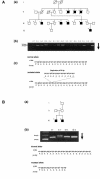Transcription factor SOX3 is involved in X-linked mental retardation with growth hormone deficiency
- PMID: 12428212
- PMCID: PMC420004
- DOI: 10.1086/344661
Transcription factor SOX3 is involved in X-linked mental retardation with growth hormone deficiency
Abstract
Physical mapping of the breakpoints of a pericentric inversion of the X chromosome (46,X,inv[X][p21q27]) in a female patient with mild mental retardation revealed localization of the Xp breakpoint in the IL1RAPL gene at Xp21.3 and the Xq breakpoint near the SOX3 gene (SRY [sex determining region Y]-box 3) (GenBank accession number NM_005634) at Xq26.3. Because carrier females with microdeletion in the IL1RAPL gene do not present any abnormal phenotype, we focused on the Xq breakpoint. However, we were unable to confirm the involvement of SOX3 in the mental retardation in this female patient. To validate SOX3 as an X-linked mental retardation (XLMR) gene, we performed mutation analyses in families with XLMR whose causative gene mapped to Xq26-q27. We show here that the SOX3 gene is involved in a large family in which affected individuals have mental retardation and growth hormone deficiency. The mutation results in an in-frame duplication of 33 bp encoding for 11 alanines in a polyalanine tract of the SOX3 gene. The expression pattern during neural and pituitary development suggests that dysfunction of the SOX3 protein caused by the polyalanine expansion might disturb transcription pathways and the regulation of genes involved in cellular processes and functions required for cognitive and pituitary development.
Figures



References
Electronic-Database Information
-
- Ensembl database, http://www.ensembl.org/
-
- GenBank, http://www.ncbi.nlm.nih.gov/Genbank/ (for SOX3 mRNA [accession number NM_005634])
-
- Online Mendelian Inheritance in Man (OMIM), http://www.ncbi.nlm.nih.gov/OMIM/ (for SOX3 [MIM 313430]
References
-
- Bienvenu T, Poirier K, Friocourt G, Bahi N, Beaumont D, Fauchereau F, Ben Jeema L, Zemni R, Vinet MC, Francis F, Couvert P, Gomot M, Moraine C, van Bokhoven H, Kalscheuer V, Frints S, Gecz J, Ohzaki K, Chaabouni H, Fryns JP, Desportes V, Beldjord C, Chelly J (2002) ARX, a novel Prd-class-homeobox gene highly expressed in the telencephalon, is mutated in X-linked mental retardation. Hum Mol Genet 11:981–991 - PubMed
-
- Brais B, Bouchard JP, Xie YG, Rochefort DL, Chretien N, Tome FM, Lafreniere RG, Rommens JM, Uyama E, Nohira O, Blumen S, Korczyn AD, Heutink P, Mathieu J, Duranceau A, Codere F, Fardeau M, Rouleau GA, Korcyn AD (1998) Short GCG expansions in the PABP2 gene cause oculopharyngeal muscular dystrophy. Nat Genet 18:164–167 - PubMed
-
- Brown LY, Odent S, David V, Blayau M, Dubourg C, Apacik C, Delgado MA, Hall BD, Reynolds JF, Sommer A, Wieczorek D, Brown SA, Muenke M (2001) Holoprosencephaly due to mutations in ZIC2: alanine tract expansion mutations may be caused by parental somatic recombination. Hum Mol Genet 10:791–796 - PubMed
-
- Carrie A, Jun L, Bienvenu T, Vinet MC, McDonell N, Couvert P, Zemni R, Cardona A, Van Buggenhout G, Frints S, Hamel B, Moraine C, Ropers HH, Strom T, Howell GR, Whittaker A, Ross MT, Kahn A, Fryns JP, Beldjord C, Marynen P, Chelly J (1999) A novel member of the IL-1 receptor family highly expressed in hippocampus and involved in X-linked mental retardation. Nat Genet 23:25–31 - PubMed
-
- Chelly J, Mandel JL (2001) Monogenic causes of X-linked mental retardation. Nat Rev Genet 2:669–680 - PubMed
Publication types
MeSH terms
Substances
Associated data
- Actions
- Actions
LinkOut - more resources
Full Text Sources
Molecular Biology Databases

